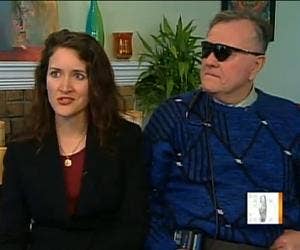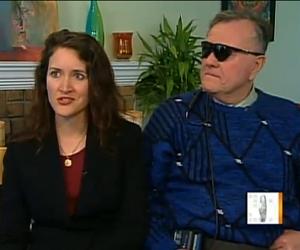Artificial Retina That Lets the Blind See Again – More Great Videos of the Argus!

Share
The blind in Europe have reason to rejoice, the world's most advanced artificial retina has just received the CE Mark, approved for use in new patients. The Argus II, developed by Lawrence Livermore National Laboratory and marketed by Second Sight, is on sale in the EU, but still awaiting FDA approval here in the US. Luckily, clinical trials are already underway and we could get the amazing device here soon. With the Argus II, blind patients use an external camera to pick up video that is wirelessly transmitted to an electrode array surgically implanted in the eye. While full vision is not restored, the 60+ electrodes allow for some distinction of outlines and other basic shapes. Definitely an improvement over blindness. In celebration of Argus' success in the EU, and in anticipation of approval in the US, I've collected a few new videos for you to enjoy. The first two show you real patients: Dean Lloyd and Barabara Campbell, are part of Second Sight's clinical trial, living with and seeing through the Argus II. They're followed with more videos that give a better explanation of the device through new animations. Check them all out below. With the CE Mark obtained, it may only be a matter of time before the Argus II could help millions around the world who have been blinded due to retinal disease. As these devices get better, the blind will become the next generation of cyborgs. Who knows, perhaps one day soon we'll move beyond simply repairing human senses and venture into augmenting them.
It's been almost a year since my last compilation of Argus videos. The technology is still the same, a camera embedded in a pair of glasses records the world in front of the patient. A wearable computer takes that image and transforms it into a basic series of impulses. That pattern is transmitted to the Argus II implant which rests inside the eye, and which is attached to the back of the eye through an electrode array. Here's Gregoire Cosendai of EPFL (the research institution leading Argus adoption in the EU) discussing the device. He makes an interesting point towards the end that the nearest term improvements are likely to be in software. Hopefully that software could be ported to early Argus II adopters so they don't miss out on the improvements.
In case the graphics in the above video weren't enough, here's the official animated description from Second Sight:
Be Part of the Future
Sign up to receive top stories about groundbreaking technologies and visionary thinkers from SingularityHub.


Gregoire Cosendai went further into detail about the Argus II at a recent TEDx conference, you can watch that 18 minute video here. For those who want to take a tour through Lawrence Livermore's labs where the device is developed, this video will satisfy.
Although software improvements may arrive first, hardware upgrades are also on the horizon. The Argus II operates with about 60 electrodes in its array. That's 60 points of data for your eye to interpret. The Argus III, currently under development at LLNL, should have 200+ electrodes. Perhaps considerably more. It will take a thousand or so to make out human faces accurately, but the Department of Energy is pushing LLNL towards that goal, and beyond.
As slow as the progress in artificial retinas has been, it shows no sign of stopping. There are other projects outside of the Argus series, at least two (one in MIT, another in Germany) show serious promise, and even have superior qualities to the Argus in some respects. I have no doubt that we could, eventually, reach a resolution that equals that of the human eye. Perhaps, with a different kind of interface, we could even see in greater detail than nature intended. Certainly improvements in cameras would allow future Argus users to see farther than normally sighted individuals. Cybernetics could seriously augment human senses, and in fact, the German artificial retina already does this in a limited way.
Yet the development of artificial retinas is not the only game in town, and there's a chance the progress towards cybernetic augmentation will be derailed...by advanced biology. It looks like it may be a race between artificial retinas and stem cell treatments to see which can restore normal human level vision first. Hans Keirstead and his team are exploring stem cell therapies that should be, all things being equal, on a time table to compete with the cybernetic developments at LLNL and elsewhere. No matter who wins that competition, millions of blind people the world over will benefit. And, while most of these therapies focus on conditions that injure the retina (such as retinitis pigmentosa) there are more treatments that could compensate other forms of blindness. Watching the videos above gives me hope that humanity may cure blindness once and for all. That day isn't here yet, but it seems nearer all the time. Congrats to Second Sight and Argus for conquering Europe. FDA, you're next!
[screen capture: CBS News]
[video credits: CBS News, Reuters via Dr. Marion Thorpe on Facebook, EPFL News, Second Sight]
[source: Second Sight]
Related Articles

New Gene Drive Stops the Spread of Malaria—Without Killing Any Mosquitoes

New Immune Treatment May Suppress HIV—No Daily Pills Required

How Scientists Are Growing Computers From Human Brain Cells—and Why They Want to Keep Doing It
What we’re reading
